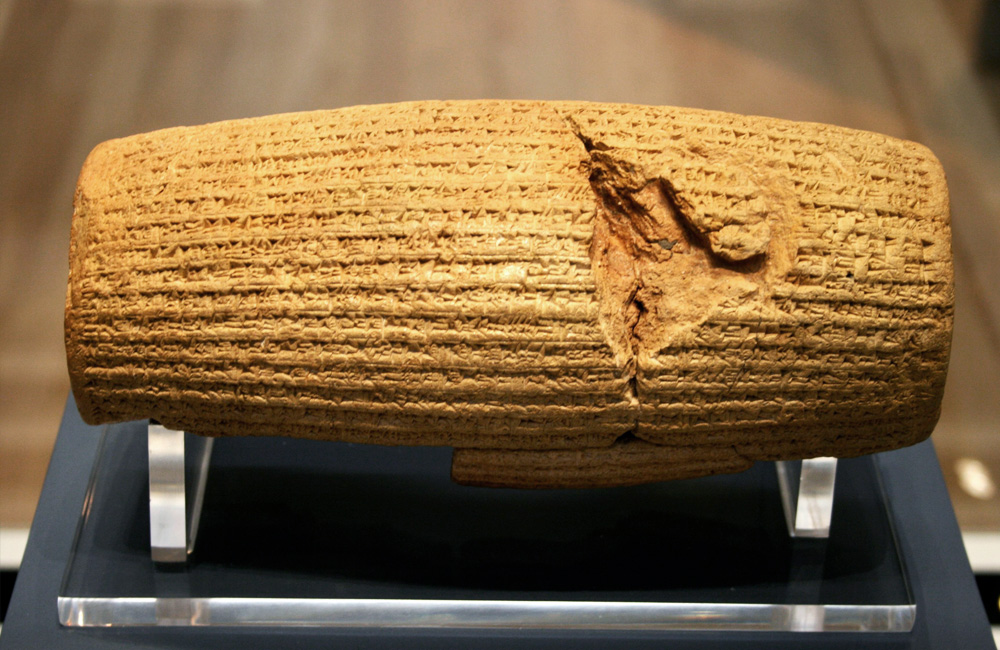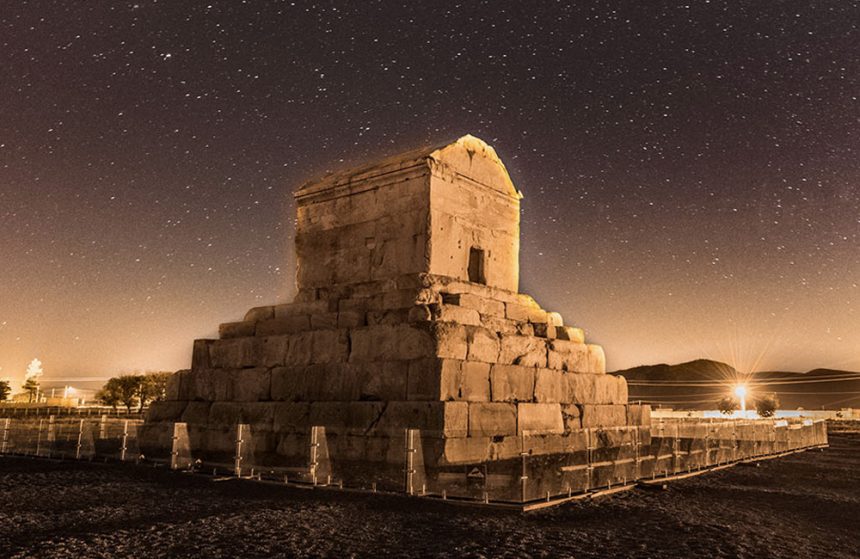It is probably not possible to skip Pasargadae if you are visiting Iran, especially the Tomb of Cyrus, the great king of Achaemenid Empire, who was the prophet of friendship and justice. After 1820, this tomb was recognized as Cyrus the Great grave. Pasargadae is almost 75km away from Takht-e-Jamshid, located in Murghab Plain.
Tomb of Cyrus is glittering like a jewel in the middle of Murghab Plain. In old ages, this plain was covered by royal gardens and constructed by huge rocks with heights of up to seven meters. This tomb is the only place in ancient Persian city of Pasargadae explained in Greek sources.
Tomb of Cyrus Appearance
Tomb of Cyrus was constructed with white limestone almost 530-540 BC, consists of two general sections, the lower part being a six stepped platform, with a rectangular base and a width of 165 square meter, and a small room of 7.5 meter width on top with wall thickness of 1.5meters, covered by a gable roof.
Building foundation (13.35 into 12.30 m) is formed by six platforms. First step is 170cm high, second and third 104 cm, and the last three steps are 57.5 cm high. Total height of the building is almost 11 meters.

Tomb of Cyrus, From Beginning until Today
Most probably this tomb has been constructed by command of Cyrus the Great, before his death, and been very well conserved during Achaemenid Empire. According to Arrian, Greek historian, during Cambyses rule, Magi in charge for his tomb used to receive a share of a sheep, some wine, food, and a horse to sacrifice for the king. When Alexander the Great invaded the tomb, Macedon army broke into the tomb, damaged the entrance and robbed the interior decoration. Later, Alexander the Macedonian ordered to repair the tomb. Hackel and Yardley, referring to the restoration of the tomb, and a quotation from Plutarch, for the punishment of the invaders, wrote that Alexander has taken this step due to his personal interest and respect in Cyrus, and for a friendly political purpose to introduce himself as a legal successor for Cyrus the Great and Achaemenid Empire. There are no records of the tomb during the Sasanid and Parthian Empire.
During the Islamic era, people believed that such huge stone construction could not be made by human, and according to Islamic beliefs, they referred it to demons under Solomon`s authority. Thus they believed that Tomb of Cyrus belongs to Solomon`s mother.
Tomb of Cyrus Epigraphy
There are no images inside and outside of the tomb, only at the entrance and under the triangle of the roof a very pale image of common twelve petals flower of Achaemenid Empire can be observed. Except this image, no epigraphy is seen in Tomb of Cyrus.
Arrian, the Greek historian, wrote that an epigraphy in Old Persian Cuneiform been found in Tomb of Cyrus, which could be translated as:
“O man, I am Cyrus, Son of Cambyses, Who founded the Persian Empire, and was the king of Asia”
Grudge me not, therefore this monument.
Aristobulus, Arrian and Strabo has described the interior of tomb decorated with a golden bed, a table set with drinking vessels and a golden coffin.
About Cyrus the Great
Cyrus the Great was founder and first Achaemenid Emperor ruling the Persian Empire 529-559 BC. There are several narratives about Cyrus the Great childhood and youth, but Herodotus quoted four stories on power achievement of Cyrus, one of them being more reliable. After defeating Astyages the last king of Median Empire, Cyrus the Great conquered the capital of Median Empire, Ecbatana. Then he defeated Croesus, the king of Lydia, and dragged to Sardis, then left his conquests to the commanders and moved back to Ecbatana.

In the spring before 539 BC, Cyrus involved in a battle with Babylon. According to historic documents and historians, Babylon was conquered with no war and bloodshed, by Gobryas, one of commanders of Cyrus the Great, at the New Year eve. Seventeen days after Babylon fell, Cyrus the Great entered the capital at 29th October 539 BC. Babylon conquest was a vital incident leading to formation of a great empire in central and western Asia, providing a chance for Jews to go back to their promised land, Israel. By the command of Cyrus the Great, Jerusalem Temple was reconstructed, and all the gold and silver stolen by Nebuchad Nezzar, King of Babylon, was returned to Jerusalem. Cyrus Cylinder, written after defeating Nabonidus and conquering Babylon, is a valuable ancient historic document. In 1971, United Nation published Cyrus Cylinder into various languages, announcing it as the first document on Human Rights, and a copy of this cylinder is kept in United Nation headquarters in New York City. Cyrus Cylinder, considered the first declaration on human rights, is now kept in Britain Museum, England.
Herodotus claims that Cyrus was murdered in a battle with Massagetai, but most of the historians deny this idea. The only trustworthy and credible ancient document pointing to Cyrus death indirectly, is two clay tablets found in Babylon belong to 11th August 530 BC, the beginning year of Cambyses “The King of the Kings” rule. These two documents may not be considered very important, but give us an estimation on Cyrus death, which might be between 12-31 August 530BC, or at least, this is the date Babylon was informed by hid death and Cambyses started his empire.
Cyrus the Great Heritage for Iranians and the World
Cyrus was not just a great conquer and king. In Persian minds, he occupied the same position as Moses for Israelites, and Romulus and Remus for Romans. The birth story of Cyrus, his delivery and training by a shepherd, reminds us of Moses story in canebrakes of Egypt and conquering his dictator father in myths.
The epic of Cyrus the Great grown amongst Persians first, and then delivered to Greeks. No wonder Xenophon called him an “Ideal Ruler” in his Cyropaedia, attempting to describe his education through the ideal ruler of ancient Persia. Nevertheless, Cyrus the Great remains as a great man who has founded a peaceful empire in the history.
He was not only a genius leader who started a great empire, but also was founder of culture and civilization of Achaemenid Empire. As we know today, Persians did not follow the Chauvinism path (an exaggerated patriotism), thus Cyrus the Great, quickly started to learn from the defeated nations. He took control of Median, united them into Persian nation and created a double kingdom of Persian-Median culture. Cyrus the Great owned the empire rituals from Medians, let them rule the empire while Persians allied their forces. A Median, is usually seen as an Achaemenid king`s counselor, or the head of ministers. According to the latest epigraphy studied in Persepolis, since Darius era, a Median is constantly seen next to a great king. Local residence of Fars, Elamites were best teachers for Persians as it is observed in epigraphy of Persepolis. You can even see Persians and Elamite tenders wearing Elamite costume in Persepolis remained epigraphy.
Recommended Reads | Shiraz
Recommended Reads | Internet Access in Iran
City/Town: Shiraz
Address: Pasargadae Area, Kurd Shol, Sa’adat Shahr- Safashahr Expwy., Saadat Shahr Town
Operating Days: Everyday
Operating Hours: 8 Am. to 6 Pm.
Neighborhood: Toll-e Takht – Pasargadae Museum – Soleiman Prison – Pasargadae Palace – Tomb of Cambyses


